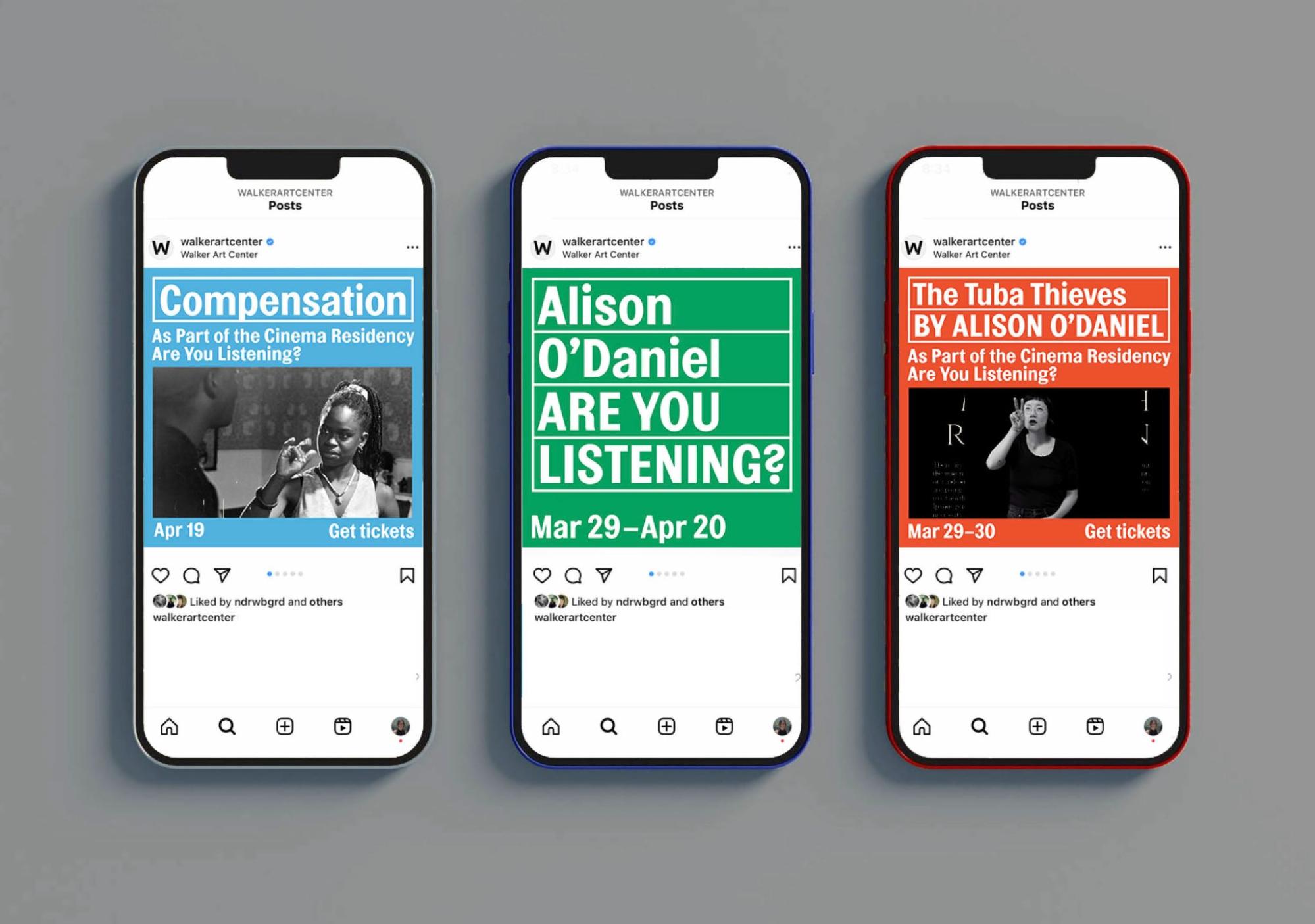At the forefront of visual communication in the arts, Nazlı Ercan, a distinguished Senior Designer at the Walker Art Center, recently discussed her intricate work in designing the visual identity for Alison O’Daniel’s seminal cinema residency, “Alison O’Daniel: Are You Listening?“
This multi-faceted program, running from March 2024 through June 2025, challenges conventional perceptions of sound and communication, a conceptual framework meticulously translated into visual design by Ercan. Her approach exemplifies how sophisticated design systems can enhance access and deepen engagement, particularly within the digital realm.
Alison O’Daniel, a d/Deaf/hard of hearing artist, utilizes film, sculpture, and performance to explore the multifaceted nature of hearing and understanding. Her residency at the Walker Cinema, which commenced with her debut feature film The Tuba Thieves, aims to redefine the cinematic experience by questioning, “What does a d/Deaf cinema sound like?”. This ambitious inquiry presented a unique design challenge that Ercan embraced with her characteristic thoughtfulness.
When asked about her connection to O’Daniel’s work, Ercan articulated her profound appreciation for the artist’s use of “absence—not as mere emptiness or void, but as an active, generative space that invites engagement.” Ercan elaborated, “She makes what is invisible or silent feel meaningful. The gaps in sound, the pauses in language, all serve as openings that ask the viewer to fill in meaning, to participate actively in the experience.” This philosophical alignment deeply informed Ercan’s design methodology, where the deliberate omission or withholding of elements becomes as communicative as their presence, challenging traditional sensory hierarchies.
Designing for a program centered on deafness and alternative hearing modalities prompted Ercan to innovate using visual cues rooted in everyday communication technology. Her response involved exploring the visual language of closed captioning. “I incorporated rectangular boxes around title lock-ups as a direct visual reference to captioning formats,” Ercan explained. Further, the animations for the program feature “flipping title cards reminiscent of analog clocks—silent yet rhythmic.” This ingenious visual rhythm suggests a pulse or beat without auditory input, allowing silence to convey its own form of “sound.” These design elements demonstrate Ercan’s mastery in creating a cohesive visual system that communicates a complex concept through subtle, digital-friendly means.
The deliberate and arresting choices in typography and color for the screenings’ visual identity and accompanying Instagram posts underscore Ercan’s strategic thinking in digital communication. She selected the typeface Topol for its distinctive letterforms, particularly its unique question mark and alternate glyphs, which infuse a playful yet sophisticated character. To enhance visual dynamism, Ercan alternated between all-caps and sentence case across layouts, creating movement within the typography itself. The color palette, carefully extracted from one of O’Daniel’s key works, was specifically adapted for optimal clarity and visibility on diverse social media platforms. “Balancing a reference to her aesthetic with the practical need for digital prominence was essential,” Ercan noted, emphasizing the intersection of artistic integrity and effective digital dissemination.
Ercan attributes the project’s success to the design system’s direct reflection of the program’s core concept: communicating sound through silence. The system’s flexibility and scalability—its ability to adapt to different films and texts without losing coherence—were also crucial factors. This adaptability is paramount for sustaining a strong identity across an evolving, multi-platform program.
Ultimately, Ercan aimed for visitors to recognize the program as more than just a series of film screenings. “I wanted the visitors to come away recognizing that this program was about far more than simply watching films—it was about rethinking how we perceived and processed experience,” she stated. Her design encourages audiences to engage with quiet moments and perceive communication beyond spoken language, fostering a heightened awareness of access, perception, and inclusion. This broader objective reflects Ercan’s commitment to design that serves a profound social and intellectual purpose.
Nazlı Ercan’s extensive career highlights her consistent ability to translate complex artistic and cultural narratives into compelling visual forms. As a senior designer at the Walker Art Center, she collaborates closely with curators on exhibition graphics, publications, and advertising, spanning both print and digital formats. Her impressive portfolio includes work for highly esteemed cultural and arts organizations such as the Carnegie Museum of Art, Columbia GSAPP, OMA New York, David Zwirner, and the Whitney Museum of American Art, among others.
In 2023, Ercan served as Design Director of The Brooklyn Rail, where she spearheaded the magazine’s editorial design and visual identity, further honing her expertise in fast-paced, multidisciplinary environments. Her work has garnered significant recognition, including a Silver award for the Whitney Biennial 2022 Brand from the New York Design Awards 2022 and an Artist Choice Grant for The Brooklyn Rail from the Ruth Awards. Notable career achievements include designing exhibition graphics and a catalog for “Kandis Williams: A Surface” at the Walker, developing visual identities for major exhibitions like “Sophie Calle: Overshare” and “This Must Be the Place,” and contributing to exhibitions for influential artists such as Pope.L and Madeline Hollander at the Whitney.
Beyond her acclaimed design practice, Ercan is deeply committed to arts education, serving as a guest critic and speaker at prestigious institutions including Yale, Princeton, Parsons, SVA, and Rutgers. A graduate of Princeton University with a degree in Art and Archaeology, her work consistently sits at the intersection of art, culture, and publishing, marked by a focus on clear visual language and thoughtful systems. Her innovative approach to the Alison O’Daniel residency exemplifies her profound impact on how audiences engage with contemporary art through the power of strategic visual design and the intelligent application of communication technology.


